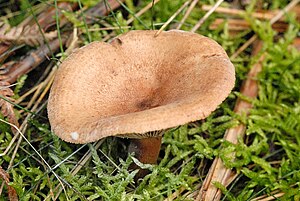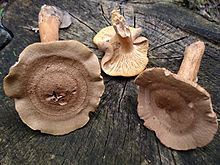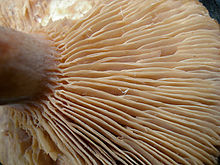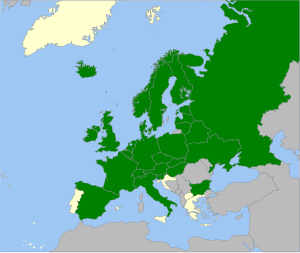Felty Milchling
| Felty Milchling | ||||||||||||
|---|---|---|---|---|---|---|---|---|---|---|---|---|

Felty milkling ( Lactarius helvus ) |
||||||||||||
| Systematics | ||||||||||||
|
||||||||||||
| Scientific name | ||||||||||||
| Lactarius helvus | ||||||||||||
| ( Fr .: Fr. ) Fr. |
The Woolly Milchling or breakage Milchling ( Lactarius helvus ) is a slightly toxic fungus art from the family of Täublingsverwandten (Russulaceae). Due to the spicy smell of lovage ( Levisticum officinale ), which is intensified when the fruiting body is dried , it is also known as Maggi mushroom or lovage milkling . The Milchling is very common in moist to boggy coniferous forests. The fruiting bodies appear between July and October.
features
Macroscopic features
The hat of the Filzigen Milchlings reaches a diameter of 4 to 15 cm. It is flesh-brown to orange-brown in color and is initially flatly arched, later depressed with a hump. The surface of the hat is fine felt. The stem becomes up to 10 cm long and up to 4 cm thick. It is usually lighter than the hat and, unlike the hat, smooth. The lamellas have grown broad. They are initially off-white with a mixed shade of pink, but they get darker as they grow. The meat is white and firm, but breaks very easily (name: Bruchmilchling!). When young fruit bodies are injured, only sparse water-clear milky sap escapes, older specimens do not milk at all. With age, the fruiting bodies develop an intense lovage odor . The smell has also been described as similar to fenugreek or celery .
Microscopic features
The spores are elliptical to broadly elliptical and on average 7.0–7.5 µm long and 5.4–5.8 µm wide. The Q value (quotient of spore length and width is 1.2 to 1.4. The spore ornament is between 0.5 and 1 (1.5) µm high and consists of a few, individual warts and short, burr ribs, which are connected to a more or less complete, irregular network with rather small meshes. The hilly spot is inamyloid. The basidia are cylindrical, bulbous or slightly clubbed and each carry four sterigms . They are 30–50 µm long and 7.5–11 µm wide.
The cylindrical to spindle-shaped, 40–70 µm long and 7–12 µm wide pleuromacrocystids have a blunt tip and are quite numerous. In older specimens, they are often partially compressed. The lamellar edges are heterogeneous, so in addition to the basidia there are also a few to numerous cheilomacrocystids . The Cheilomakrozystiden are diverse, they can be cylindrical to slightly clubbed and are often septate one to five. This is a characteristic that is unique among European dairy babies. Sometimes the 20–75 µm long and 7–9 µm wide cheilomacrocystidia are contracted at the septa and sometimes the cell wall is slightly thickened.
The hat skin ( Pileipellis ) is only slightly differentiated and morphologically stands between a Trichoderm and a Cutis . It consists of partially parallel, but mostly irregularly intertwined 4–12 µm wide hyphae , with individual lactifera in between .
Species delimitation
The curdled milkling is easy to recognize by its maggi-like smell and the water-clear milk. The hat color, the size and the dry, finely felted hat skin alone are sufficient characteristics for a reliable determination. At best, it can be confused with the similarly aromatic but non-toxic camphor milkling ( Lactarius camphoratus ). However, this is much smaller and darker in color. The odor of maggi only develops in him when it dries.
ecology
The Milchling can be found in spruce, fir and spruce forests, in spruce forests, as well as in spruce, pine and birch bog forests and in bogs and peat cuttings. Sometimes it can also be found under its host trees in acidic beech forests.
The Bruchmilchling likes alternately dry to wet, shallow to deep, acidic soils that have to be extremely low in bases and nutrients. It is not uncommon for it to appear on podsolized brown and parabrown earths, podsoles , gley . Pseudogley and peat soils. It only grows over limestone or basic rock if it is covered by a thick layer of needle litter, raw humus or mold or in wet depressions covered by thick layers of peat moss. The fruiting bodies appear between July and the end of October, often in the middle of peat moss. Its main growing season is late summer. The Bruchmilchling is widespread from the lowlands to the mountains.
distribution
The felty milkling was found in North Asia (Siberia, Japan, Korea), North America (USA, Canada) and in Europe. It is a temperate to boreal species. In southern Europe, the Milchling is only found in the mountains. In Western Europe it is scattered from France, over the Benelux countries to Great Britain and Ireland. It is rare in Ireland and quite common in Scotland. The fungus occurs all over Central Europe and is widespread here. In the east and northeast the fungus occurs as far as Russia and in the north throughout Fennoscandinavia . The fungus is very common in Eastern and Northern Europe, but is absent in the far north.
In Germany, the curdled milkling can be found from the Danish border and the North and Baltic Sea islands to the Bavarian Alps. In the Alps you can find it up to the tree line. But overall the species is only moderately widespread, with areas where the Milchling is quite common, while it is largely absent in all limestone areas. The Milchling is also common in Switzerland, but not often.
Systematics
The curdled milkling is placed in the Coloratini subsection , which in turn is in the Colorati section. The representatives of the subsection have dry, more or less flaky to felty hats. The milk is white or watery and invariable in the air. The spores are more or less ornamented. Closely related types of curdled milkling are the pale coconut flake milkling ( L. glyciosmus ), dark coconut flake milkling ( L. mammosus ) or purple milkling ( L. lilacinus ).
Subspecies and varieties
- Lactarius var. Albidus Bon & Hausknecht
- Young fruit bodies of the albidus variety have completely white, later whitish or light creamy white colored hats. They are a bit smaller on average. Young specimens have recently grown, non-sagging lamellae. Somewhat slimmer hyphae are found in the cap skin (epicutis), and the hyphae end links are slightly gelled.
meaning
toxicity
Due to its intense smell and taste, the Filzige Milchling is dried and pulverized in small quantities and used as a spice mushroom, whereby the aroma only consists of a musty component. It is better to use the camphor milkling for this, it retains its aroma even after heating. The typical smell of curry or lovage ( " Maggia Roma ') is based on that contained in the fruiting bodies flavoring sotolone .
Both raw and prepared, the mushroom is slightly poisonous. A sesquiterpene is suspected to be a toxin , but it has not yet been precisely identified. The toxin triggers nausea and diarrhea, accompanied by dizziness and shivering. Symptoms can appear as early as 15 minutes after consuming the fruiting bodies. In October 1949 there was mass poisoning in Leipzig , a total of 418 people were affected.
literature
- Michael Jordan: Encyclopedia of Fungi of Britain and Europe . Frances Lincoln, London 2004, ISBN 0-7112-2378-5 , p. 304.
- Hans E. Laux: The new cosmos PilzAtlas . Franckh-Kosmos, Stuttgart 2002, ISBN 3-440-07229-0 , p. 192.
- Sven Nilson, Olle Persson: Fungi of Northern Europe 2: Gill-Fungi . Penguin Books, London 1977, ISBN 0-14-063006-6 , p. 106.
- Walter Pätzold, Hans E. Laux: 1mal1 of collecting mushrooms . Franckh-Kosmos, Stuttgart 2004, ISBN 3-440-09692-0 , p. 199.
Individual evidence
- ^ Synonyms of Lactarius helvus. In: speciesfungorum.org. Index Fungorum, accessed June 20, 2011 .
- ↑ Jacob Heilmann-Clausen among others: The genus Lactarius . Fungi of Northern Europe. Ed .: The Danish Mycological Society. Vol. 2, 1998, ISBN 87-983581-4-6 , pp. 174-75 .
- ↑ a b Josef Breitenbach, Fred Kränzlin (ed.): Pilze der Schweiz. Contribution to knowledge of the fungal flora in Switzerland. Volume 6: Russulaceae. Milklings, deafblings. Mykologia, Luzern 2005, ISBN 3-85604-060-9 , p. 68.
- ↑ Ewald Gerhart (Ed.): Pilze . tape 1 : Lamellar fungi, deafblings, milklings and other groups with lamellae. BLV Verlagsgesellschaft, Munich / Vienna / Zurich 1984, ISBN 3-405-12927-3 , p. 295 .
- ↑ a b c German Josef Krieglsteiner (Ed.), Andreas Gminder , Wulfard Winterhoff: Die Großpilze Baden-Württemberg . Volume 2: Stand mushrooms: inguinal, club, coral and stubble mushrooms, belly mushrooms, boletus and deaf mushrooms. Ulmer, Stuttgart 2000, ISBN 3-8001-3531-0 , p. 411.
- ^ Lactarius helvus in the PILZOEK database. In: pilzoek.de. Retrieved September 15, 2011 .
- ↑ Worldwide distribution of Lactarius helvus. In: GBIF Portal / data.gbif.org. Retrieved September 14, 2011 .
- ↑ Jacob Heilmann-Clausen among others: The genus Lactarius . Fungi of Northern Europe. Ed .: The Danish Mycological Society. Vol. 2, 1998, ISBN 87-983581-4-6 , pp. 271-73 .
- ↑ Denchev, Cvetomir M. & Boris Assyov: CHECKLIST OF THE MACROMYCETES OF CENTRAL BALKAN MOUNTAIN (BULGARIA) . In: Mycotaxon . tape 111 , 2010, p. 279–282 ( online [PDF; 592 kB ]).
- ^ TV Andrianova et al .: Lactarius of the Ukraine. Fungi of Ukraine. In: www.cybertruffle.org.uk/ukrafung/eng. 2006, accessed January 11, 2012 .
- ^ Sylvie Rapior, Françoise Fons, Jean-Marie Bessière: The fenugreek odor of Lactarius helvus . In: Mycologia 92. Mycological Society of America 2000. pp. 305-308. doi: 10.2307 / 3761565
- ↑ G. Klemm: Observations on the course of a mass poisoning with the fracture stimulus Lactarius helvus Fries . In: Mycologisches Mitteilungsblatt 5. 1961. pp. 1-4.
Web links
- Mushroom database of the toxicological department of the Rechts der Isar Clinic . Information on the appearance and toxicity of the felty milkling.
- Frank Moser: Art portrait of the Filzigen Milchling . On: Natur-Lexikon.com . Retrieved November 15, 2011.
- Ariana Verrilli: Lactarius helvus , the maple syrup milky cap (in English) . On: Cornell Mushroom Blog . August 19, 2009. Retrieved November 15, 2011.


